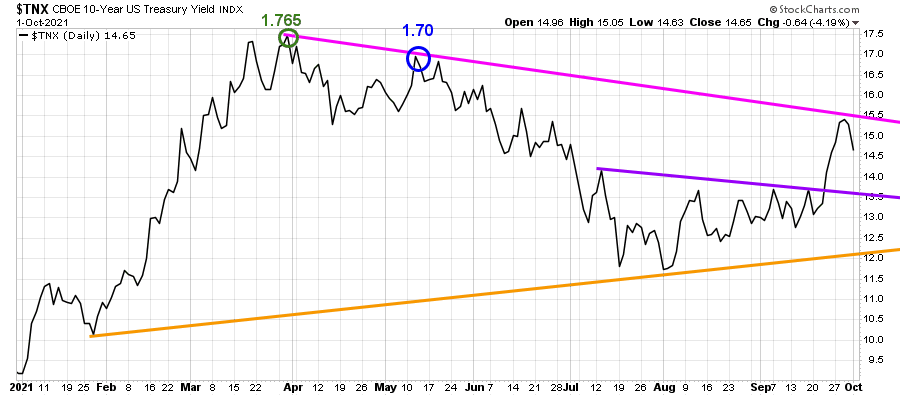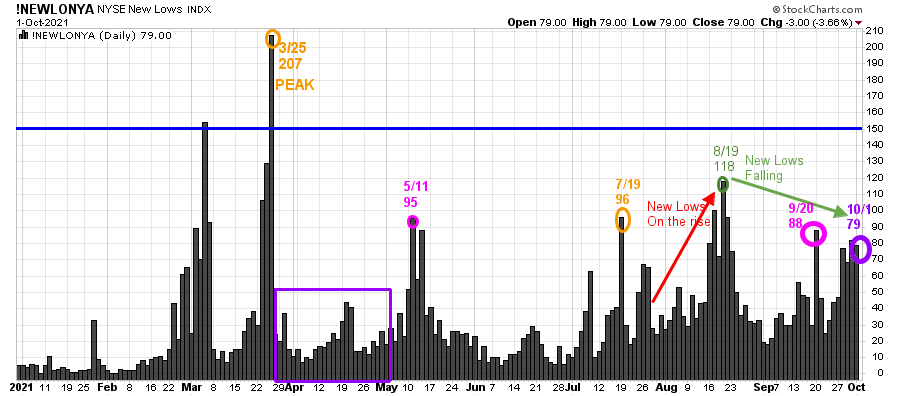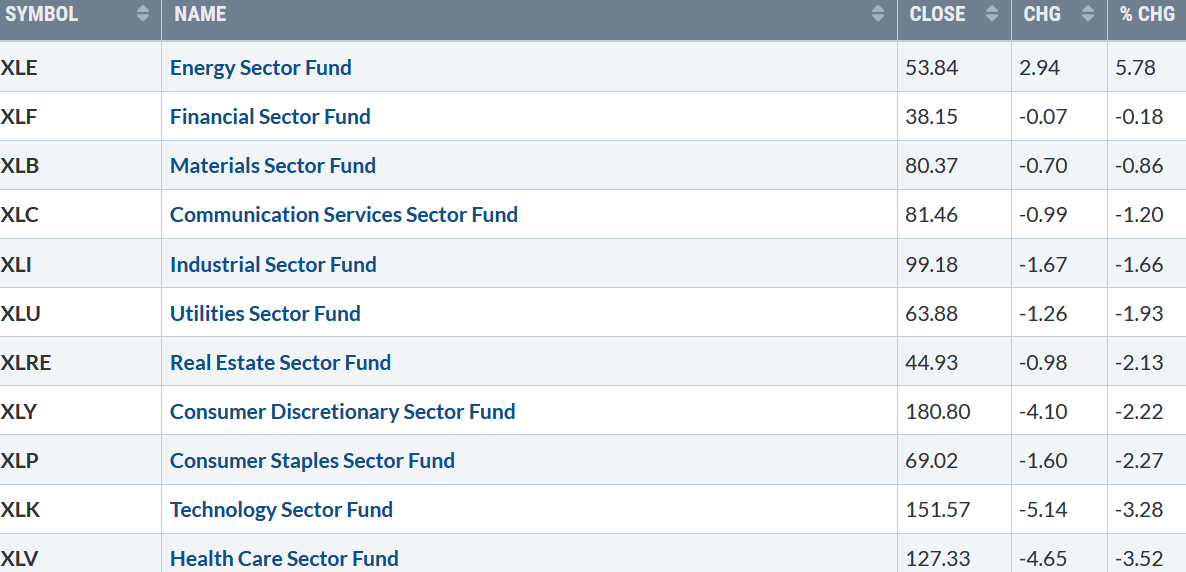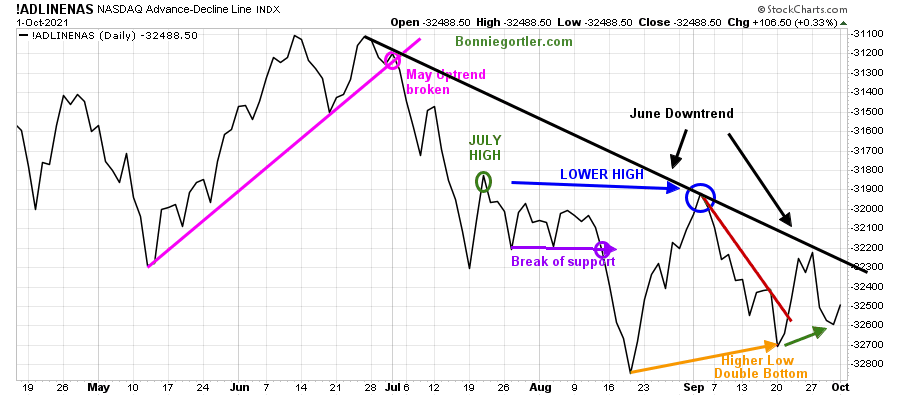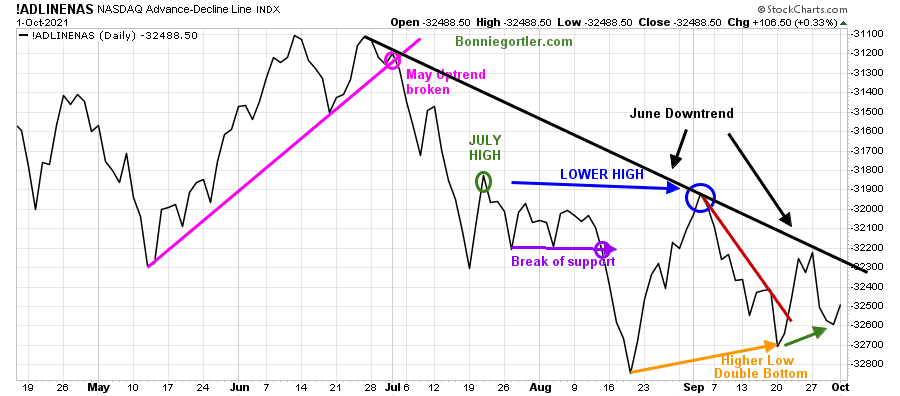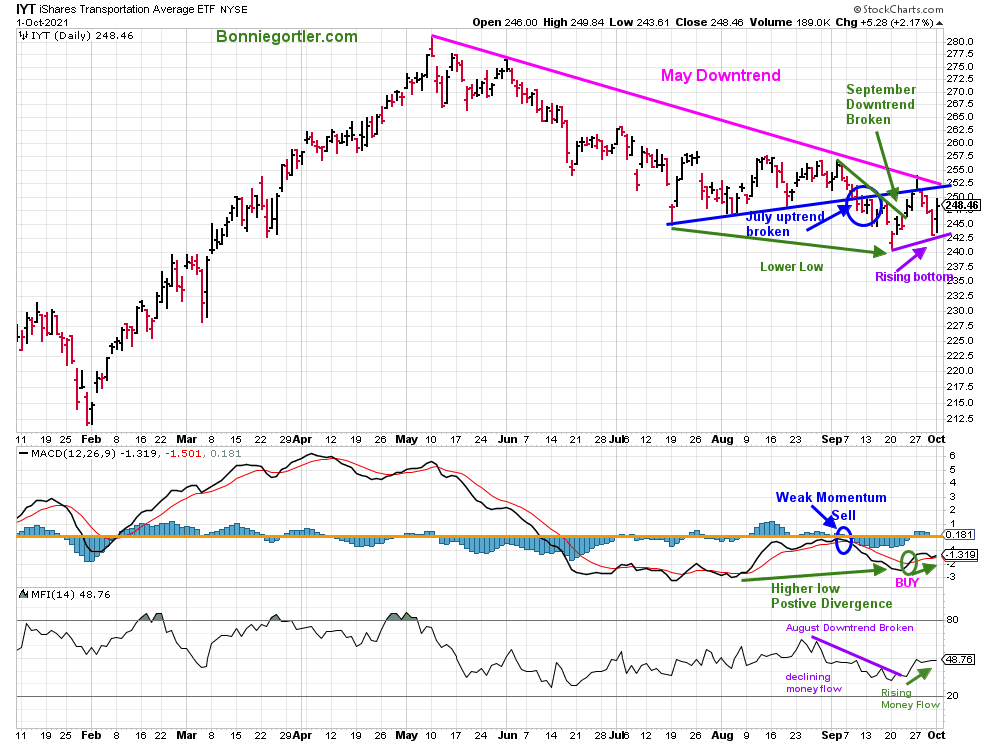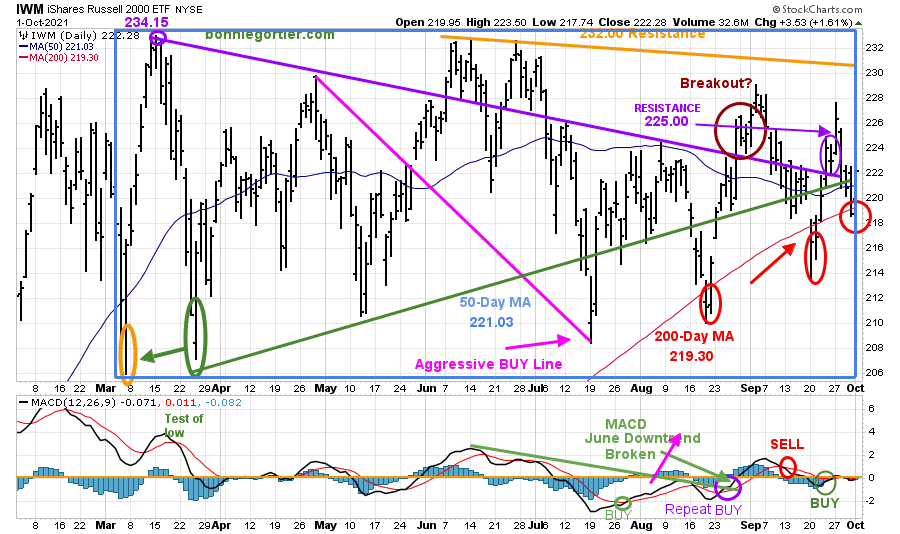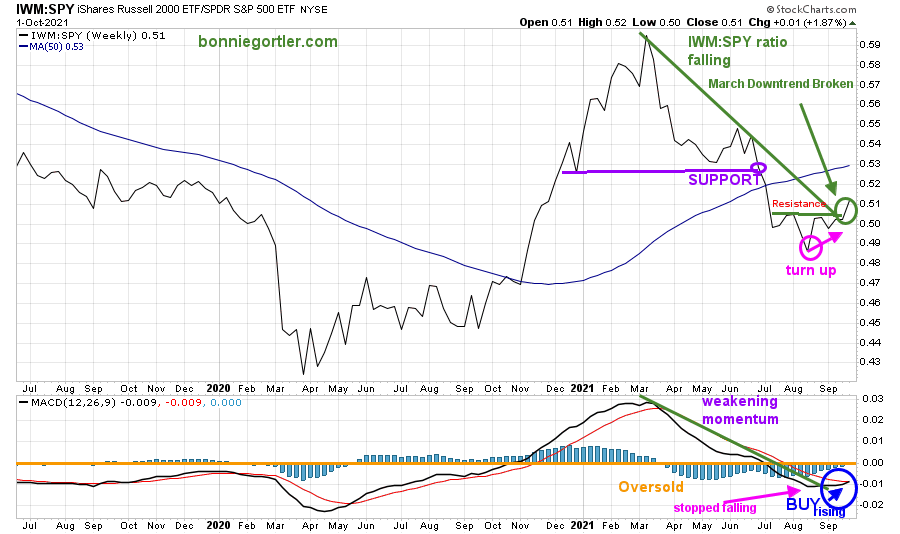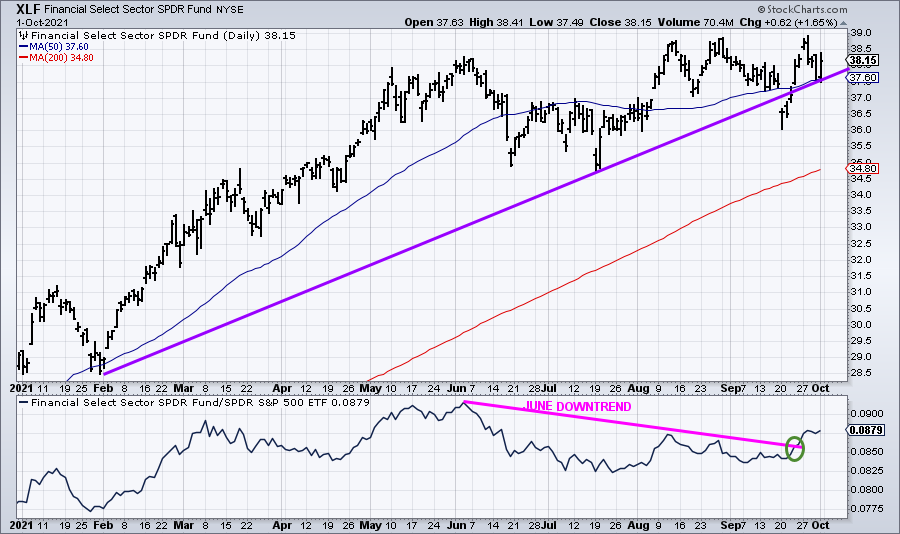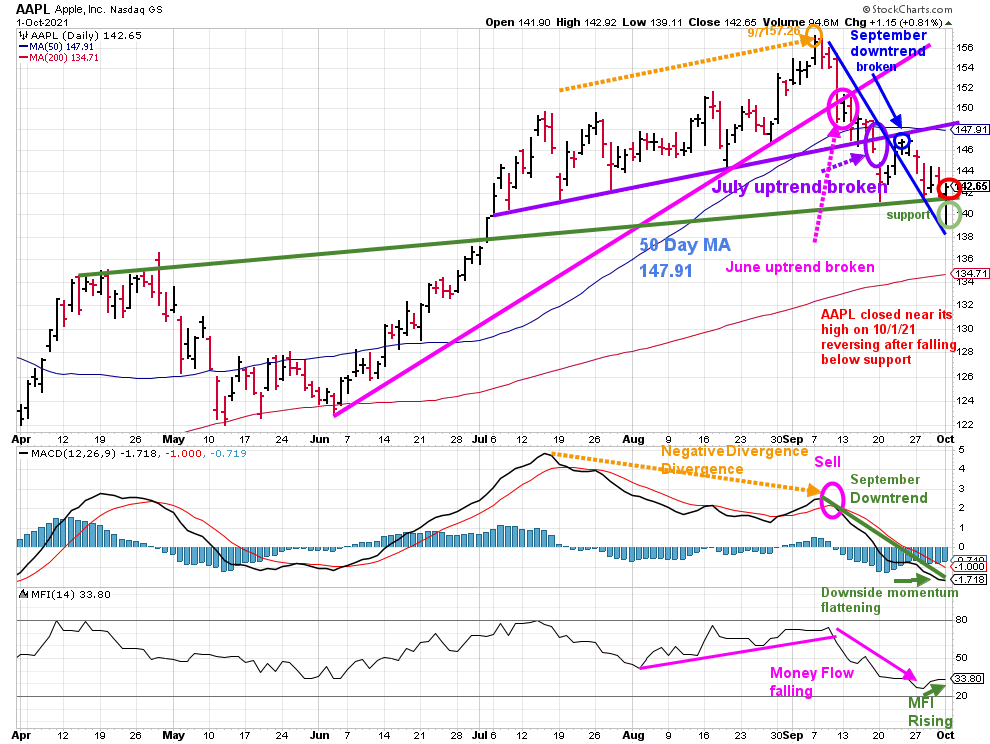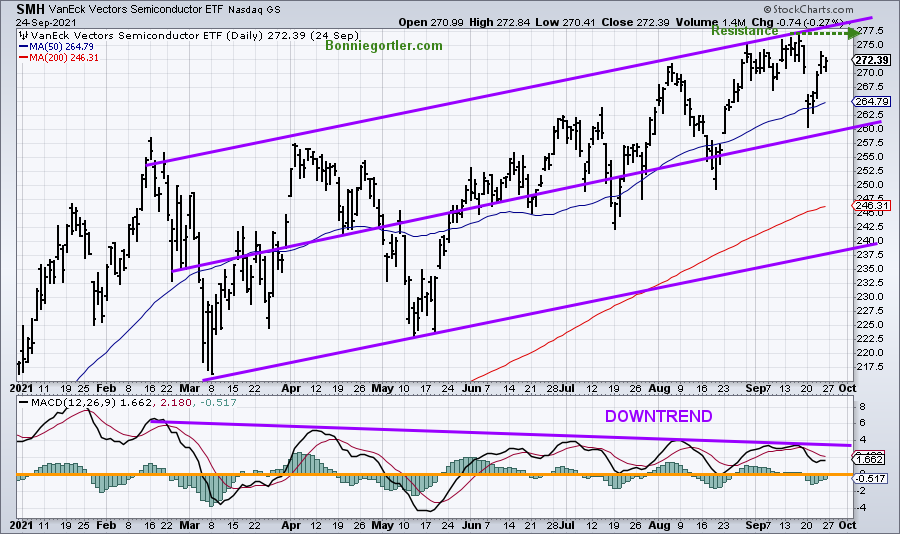Market Wealth Update Week Ending 10/01/21
Bulls recaptured control Friday, salvaging some of September’s carnage. Only one S&P sector finished higher the week ending 10/1/21, with seven sectors fell less than SPDR S&P 500 ETF Trust (SPY), down -2.18%. Energy (XLE) was strong again, the third week in a row gaining +5.78%. Financials (XLF) were only slightly down, -0.18%. Technology (XLK) and Healthcare (XLV) were the weakest, down -3.28% and -3.52%, respectively.
S&P SPDR Sector ETFs Performance Summary
Week Ending 10/01/21
Source: Stockcharts.com
The S&P 500 ended a seven-month winning streak. The Dow fell -1.36% for the week; the S&P 500 down -2.21%, and Nasdaq -3.20%. The Russell 2000 Index down -0.29% and the Value line Arithmetic Average down -0.50% both holding up better than the major averages.
Market breadth for both the NYSE and Nasdaq was negative. The New York Stock Exchange Index (NYSE) had 1560 advances and 1908 declines. Nasdaq had 1961 advances and 2861 declines.
Figure 1: 10-Year US Treasury Yields
Source: Stockcharts.com
10-Year U.S. Treasury yields rose to 1.56% on 9/28 and pulled back to close at 1.465. Support is 1.35%. A close above 1.55% would imply a further rise in yields toward 1.70%, the May high followed by the March high of 1.765 (Figure 1).
Figure 2: Daily New York Stock Exchange (NYSE) New Lows
Source: Stockcharts.com
On 3/25/21, the NYSE New Lows peaked at 207 (orange circle) and immediately contracted (purple rectangle), followed by a jump to 95 on 5/11. New lows then contracted from May to 7/19, before rising to 96 (orange circle), peaking at 118 (green circle) on 8/19, then declined.
Watching New lows on the New York Stock Exchange is a simple technical tool that helps awareness about the immediate trend’s direction. Learn more tips in my book, Journey to Wealth. The market is very strong when the New Lows are below 25 (Very Low Risk and prices tend to rise). When New Lows are between 25 and 50, the risk is low, and prices tend to rise.
Despite the sell-off, new lows closed at 79 on 10/1, below the 8/19 peak (green circle) of 118. A major correction is not likely until new lows rise and close above 150 (blue line).
“Losing potential profits hurts the ego; losing money really hurts.”-Gerald Appel
Bonnie’s ETFs to Watch Now
Figure 3: Performance week of 9/24/21 – 10/1/21
Source: Stockcharts.com
Positives
- Nasdaq dropped -3.20%, but the daily Nasdaq-line AD-Line had a pattern of higher highs (Figure 5).
- The bearish sentiment (AAII Sentiment Survey as of (9/29) reached a one-year high (contrary indicator) and remained below the historical average for the third consecutive week. 28.1% bulls and bears, 7%. Source: American Association of Individual Investors.
- Transports (IYT) broke the short-term September downtrend combined with a MACD buy on rising money flow. (Figure 7).
- The Russell 2000 weekly relative strength ratio to the S&P 500 (IWM/SPY) closed above July resistance (Figure 9).
- The Bullish Percent Index of Nasdaq is below 50, a potential triple bottom.
Negatives
- Lord Abbett High Yield (LAYYX), an open-end high yield corporate bond fund, closed down for the week, failing to make a higher high as well as taking out the mid- September low. (Figure 5).
- Transports (IYT) longer trend from May remains down (Figure 7).
- The Nasdaq-line weekly AD-Line is weak and remains below where it broke down in July (Figure 6).
- New Highs remain well below the peak reading of 708 set on 2/8, closing at a paltry 82 on 10/1.
- Nasdaq Trust (QQQ) and Semiconductors (SMH) continue to lag (Figure 11 and Figure 13).
Figure 4: LORD Abbett High Yield Fund
Source: Stockcharts.com
Lord Abbett High Yield (LAHYX), an open-end high yield corporate bond fund, broke its uptrend in July, a false breakdown, and then recovered to make a new high in early September.
Last week LAHYX failed to make a higher high and turned down, making a lower low than mid-September, giving a warning a test of the July low is likely (Figure 4).
A close below the July low would be negative and warn of further potential weakness in Hi Yields and U.S. Equities.
Figure 5: Daily Nasdaq Advance-Decline Line
Source: Stockcharts.com
The Daily Nasdaq AD-Line broke down in July (pink line) and trended lower into August after making lower highs in July. The Nasdaq AD-Line made a low in August and turned up unable to get through the July high (green circle).
The short-term September downtrend (red line) formed a rising double bottom (orange arrow). The AD-line failed to get through the June downtrend (black line) and turned down. However, the higher low is positive.
An improvement in breadth breaking the downtrend this week would be short-term bullish, confirming strength in Nasdaq. On the other hand, continued negative breadth that penetrates the August low would be short-term bearish, implying more weakness to follow in Nasdaq.
Figure 6: Weekly Nasdaq Advance-Decline Line
Source: Stockcharts.com
The Nasdaq-line AD-Line closed at its lowest low since October 2020 in early August. A suspect rally followed, failing to get above the uptrend line (red line), where it broke down in July (green circle).
A turn-up is needed penetrating the downtrend line (in red) over resistance for broad participation in Nasdaq stocks. If breadth weakens and takes out the August low, a more severe correction is likely.
Figure 7: Transportation Average
IYT was down -0.89%, closing at 248.46. Transports (IYT) have remained in a downtrend since May (pink line). However, it’s positive the short-term downtrend from September was broken (green line) and appears to have successfully tested the low.
MACD (middle chart) generated a buy, with a shift in money flow (lower graph) to rising from declining. IYT will confirm MACD if IYT closes above 252.50, breaking the May downtrend and a rising MACD.
The continuing rise in money flow would be bullish.
Figure 8: Daily iShares Russell 2000 (IWM) Price (Top) and 12-26-9 MACD (Bottom)
The top portion of the chart is the daily iShares Russell 2000 Index ETF (IWM), the benchmark for small-cap stocks, with a 50-Day Moving Average (MA) (blue line) and 200-Day Moving Average (MA), that traders watch and use to define trends.
IWM made a low on 3/5, then peaked at 234.15 (purple circle), followed by declines to test the March lows and March high, but no advance or decline out of the trading range (blue rectangle).
Last week, IWM fell below the 200-day Moving Average (red circles) and recovered for the third time. The buyers stepped in on 10/1 at the lower support of 218.00 but closed below old resistance at 225.00 and 232.00.
Support is at 218.00 followed by 214.00 and 210.00. A close below 205.89, the intraday low of 3/5 would be negative and give lower downside objectives.
The bottom half of the chart is MACD (12, 26, 9), a measure of momentum. After breaking the June downtrend, MACD gave repeat buys in August but no meaningful rally. MACD is on a buy. No strength yet, but I’m optimistic.
Small caps show signs of improving relative strength compared to the S&P 500, and the underlying tape action is improving.
Figure 9: Weekly iShares Russell 2000/S&P 500 (IWM/SPY) Relative Strength Ratio
Source: Stockcharts.com
The weekly IWM /SPY ratio fell below support in June (purple line). With the late August gains in IWM, the IWM /SPY ratio turned up. However, it failed to get through the July resistance and the July downtrend.
The IWM/SPY ratio turned up this past week, penetrating August resistance and breaking the March downtrend (green circle). The lower chart IWM/SPY MACD ratio confirms the breakout, rising and now on a buy (blue circle).
Relative strength implies the odds are in favor for Small Caps to outperform the S&P 500.
Figure 10: Daily Financial Select Sector SPDR (XLF) Price (Top), XLF/S&P 500 (XLF/SPY) Relative Strength Ratio (Bottom)
Source: Stockcharts.com
XLF (top chart) was weak in September, breaking the February uptrend. With weekly negative divergences (chart not shown), I thought money would flow out of financials. However, sparked by rising yields, XLF reversed sharply to the upside and look favorable in the near term.
Notice the lower chart. The Financial (XLF/SPY) ratio was weaker than the S&P 500 since June. However, this past week the ratio turned up and broke the downtrend implying Financials are likely to work their way higher and be stronger than the S&P 500.
Figure 11: Daily Invesco QQQ Trust Nasdaq (QQQ) Price (Top) Money Flow (Bottom)
Source: Stockcharts.com
The chart shows the daily Invesco QQQ, an exchange-traded fund based on the Nasdaq 100 Index with its 50-Day Moving Average and 200-Day Moving Average.
The March uptrend (top chart) remains intact (pink line). In June, QQQ was in a trading range (orange rectangle) and then broke out to the upside in August but fell below the 370.00 where the QQQ broke out in early September.
QQQ was under heavy selling pressure falling -3.52% this past week. QQQ is in a short-term downtrend (blue line), not showing any real strength.
Resistance is at 365.00 followed by 370.00. It would be positive if QQQ could break the September downside trendline (blue line). The upside objective remains at 390.00 unless QQQ closes below 350.00.
Support is at 350.00 followed by 340.00 (purple line) with the 200-day MA, just below 339.46 at this writing.
Money flow (lower chart) is falling (redline), trending lower, implying that growth stocks remain out of favor.
Figure 12: Apple (AAPL) Daily
Source: Stockcharts.com
Apple (AAPL) peaked on 9/7/21 at 157.26 (orange circle). AAPL then declined to fall below its June uptrend (pink circle) and below its 50-day Moving Average later in the month.
It was positive the previous week that AAPL broke its short-term September downtrend (blue line). However, it failed to close above the 50-Day MA or above the July uptrend (purple line) and continued lower.
AAPL closed below the first support at 144.00, closing at 142.65, down -2.9%. On the plus side, AAPL closed near its high on 10/1, with rising money flow.
MACD (middle chart) is on a sell, but downside momentum is flattening. Support is at 141.00, followed by 134.00. Resistance is at 144, followed by 148.00 and 155.00.
Although there is an improvement, it’s safer to wait for new buys, with the weekly chart (not shown) on a fresh MACD sell and money flow still declining.
Figure 13: Van Eck Semiconductors (SMH) Daily
Source: Stockcharts.com
Weakness in Semiconductors (SMH) was a clue to last week’s weakness in the overall market, down -5.84%. (SMH) have not yet broken out to the upside in price or momentum.
MACD, lower chart is on a sell, not yet oversold, below 0.
Until Semiconductors (SMH) begin to show leadership, the risk is high.
Potential Buying Opportunity in Small Cap Value
IJS iShares S&P Small-Cap 600 Value
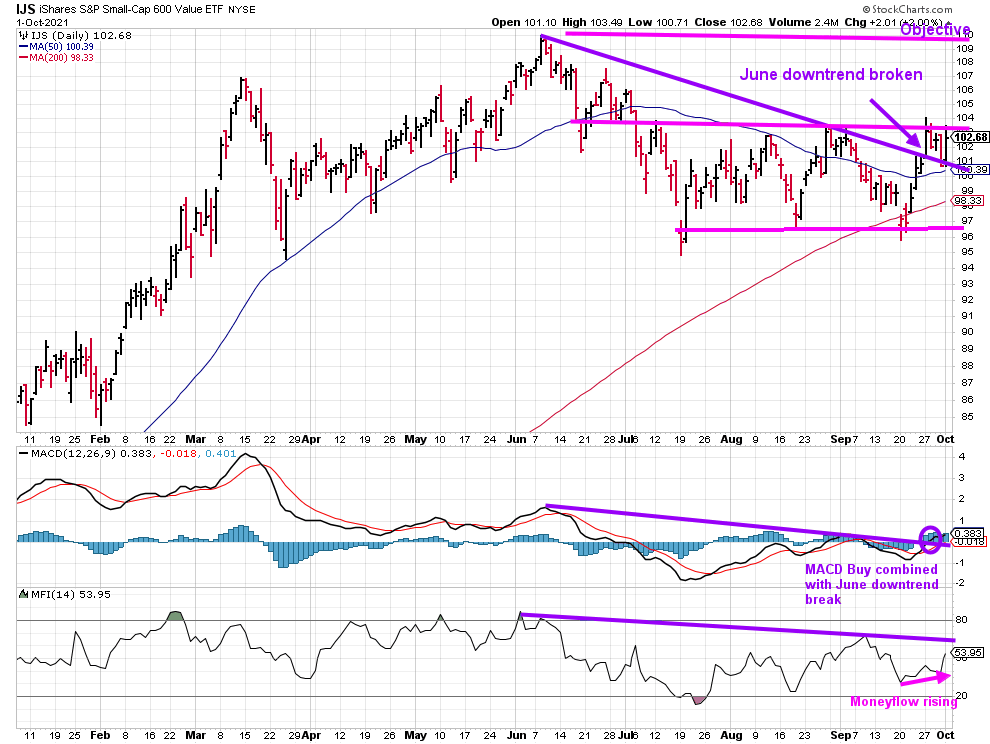 The iShares S&P Small-Cap 600 Value ETF (IJS) tracks an index of small-cap US stocks that provides exposure to the US small-cap companies that are considered undervalued by the market relative to other companies. The top sectors are Financials 34.09%, Consumer Cyclicals 16.41%, and 14.62% Industrials with the largest holding of the fund only 1.39%. Learn more about its holdings here.
The iShares S&P Small-Cap 600 Value ETF (IJS) tracks an index of small-cap US stocks that provides exposure to the US small-cap companies that are considered undervalued by the market relative to other companies. The top sectors are Financials 34.09%, Consumer Cyclicals 16.41%, and 14.62% Industrials with the largest holding of the fund only 1.39%. Learn more about its holdings here.
IJS bucked the trend last week, gaining 1.78%, breaking its June downtrend. MACD generated a new buy combined with breaking the June downtrend. It’s also positive money flow is now rising.
Summing Up:
After back-to-back small changed weeks, last week stocks fell sharply last week as the S&P 500 had its worst September since 2011. The Nasdaq and S&P 500 had their worst month since September 2020. Friday, the first trading day of October, was a different story. Stocks reversed off their lows and closed near their highs with Transports, Small Caps both Growth and Value, and Financials leading the market higher, deflating the bears. Small caps show signs of improving relative strength compared to the S&P 500. Semiconductors and Technology need to show some leadership to confirm that the rally will continue in the short term. Uncertainty remains economically and politically. Expect the high day-to-day volatility to continue as earnings season begins.
Remember to manage your risk, and your wealth will grow.
If you liked this article, you will love my Free Charting Master Class. Get it here:
I would love to hear from you. If you have any questions or comments or would like to talk about the market, click here.
Disclaimer: Although the information is made with a sincere effort for accuracy, it is not guaranteed that the information provided is a statement of fact. Nor can we guarantee the results of following any of the recommendations made herein. Readers are encouraged to meet with their own advisors to consider the suitability of investments for their own particular situations and for determination of their own risk levels. Past performance does not guarantee any future results.


